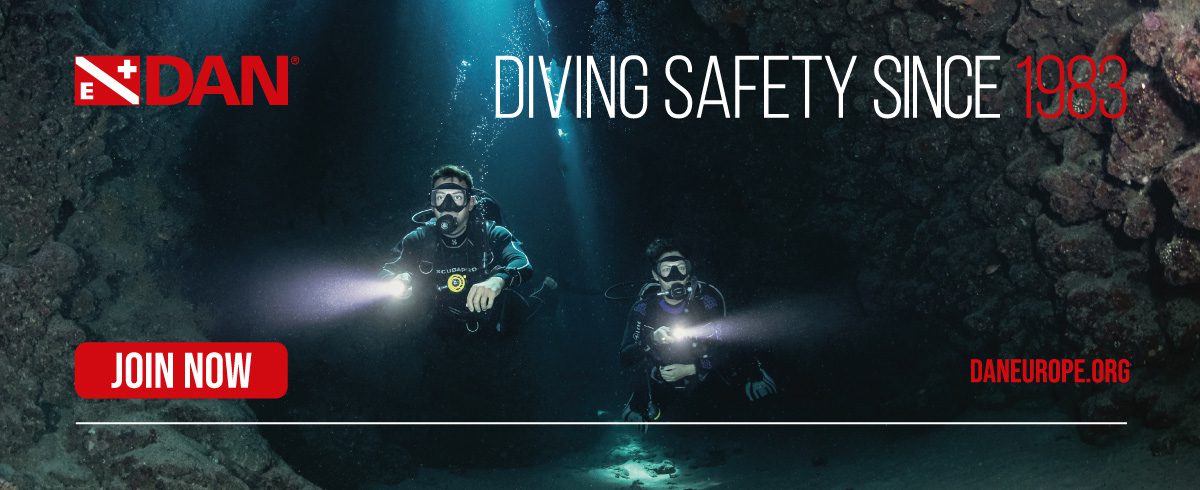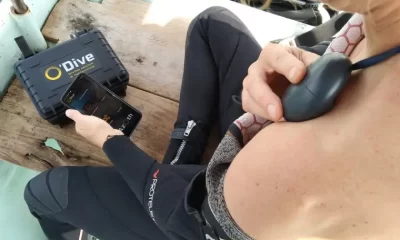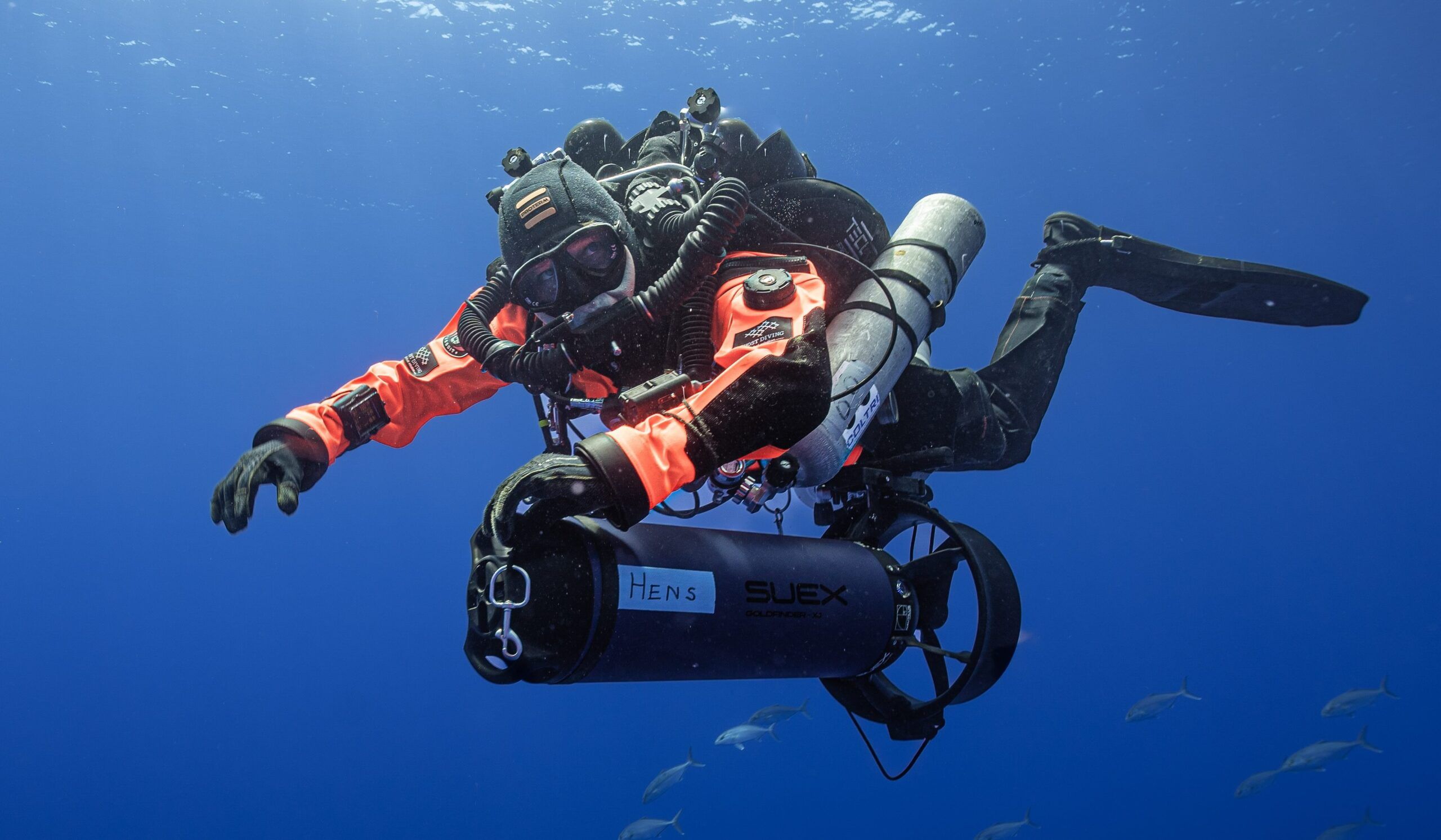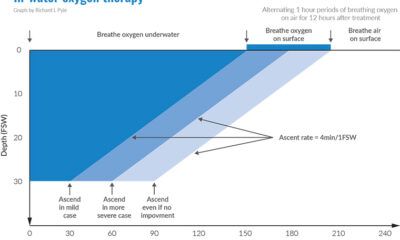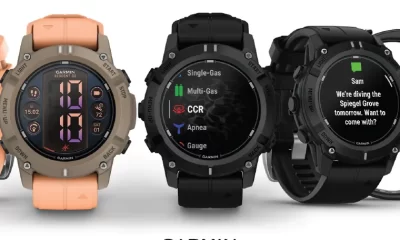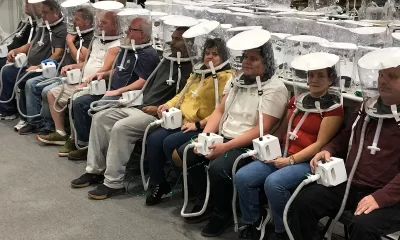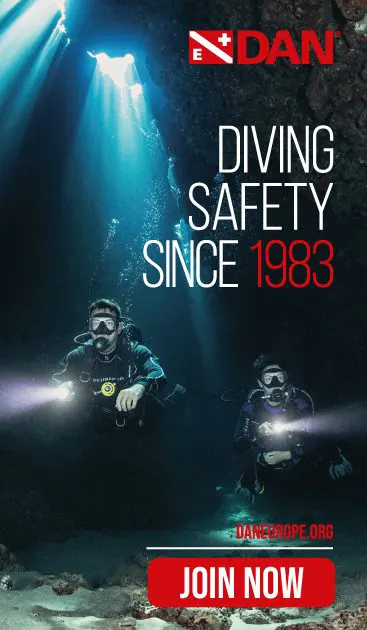DCS
The SOS Automatic Decompression Meter: Bend-O-Matic or Game Changer?
Introduced in 1959, the Italian SOS Deco Meter—the forerunner of modern dive computers—was the first decompression device used by sports divers that automatically tracked users’ dive profiles. Here former French mine clearance diver, instructor, and historian Stephane Eyme takes us on a deep dive into SOS’s analog technology, compares its decompression prescriptions with those of the US Navy and French air diving tables for single and repetitive dives, and offers his perspective on its impact on the market.
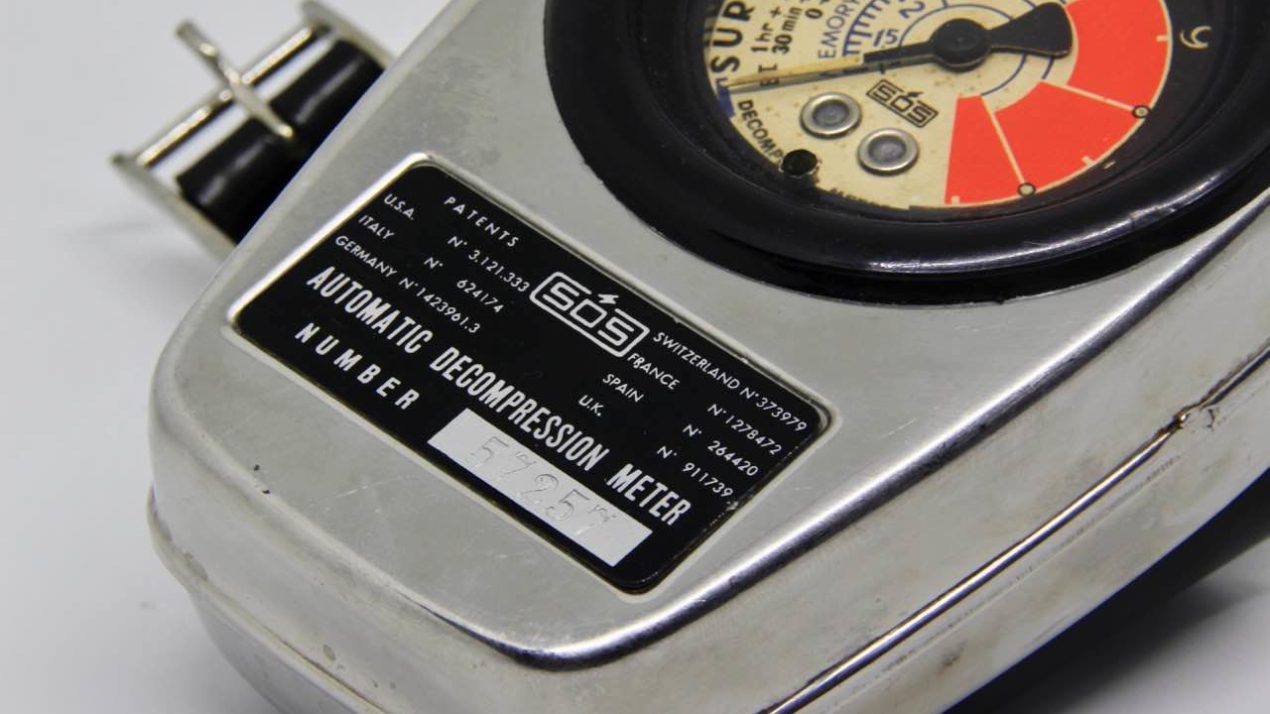
Text by Stephane Eyme. Photos and illustrations courtesy of Stephane Eyme. This story was first published on vintagescubadiving.com.
SOS Automatic Decompression Meter was the first mechanical analog dive computer.

The SOS Automatic Decompression Meter (“DeComPressimetro,” or DCP) was introduced in 1959 by Italians Victor Aldo De Sanctis—a known U/W cinematographer at the time—and engineer Carlo Alinari, both co-founders of Strumenti Ottici Subacquei (SOS), a Torino, Italy-based company specializing in scuba diving instrumentation.
DCP provided a decompression profile to scuba divers during an actual dive.
The device was very simply manufactured. It consisted of a waterproof deformable chamber filled with gas connected to a smaller, rigid chamber through a semi-porous ceramic cartridge.

The rigid chamber was equipped with a bourdon tube to measure the inside pressure. A calibrated indicator interpreted these data to provide divers with a decompression status. The whole mechanism was enclosed in a metal and plastic housing.

Straightforward dive operation mode
During the dive:

Ascent and deco stops:

Quite a hit!
The device was distributed by SOS itself and many notable dive equipment companies. Throughout the US and Europe, Scubapro, Healthway, Beuchat, Sporasub, Nemrod, Barakuda and others, all sold the DCP at some point until the 1970s.

And so, the SOS DCP became the first successful decompression instrument sold at large scale to divers around the world. Scripps Institution of Oceanography reported more than 50,000 units sold.

A mind-blowing concept?
When the SOS DCP came out, the diving world already knew quite a bit about the decompression process.
J.C. Haldane published his perfusion parallel compartments model in 1908, and a boom in decompression research followed..
We knew that human body tissues became saturated from a few minutes to several hours depending on the tissue, that saturation followed a logarithmic curve, and that it was symmetric with the desaturation process.
We knew supersaturation ratios decreased linearly with increased ambient pressure (M-values), and that they were different for each compartment.
Based on this knowledge, divers created and used several sets of deco diving tables, for example; US Navy 1956 and the GERS 65.
While it was true that , the diving community had long been aware that decompression was complex and had to account for a wide variety of factors,even with all those considerations, deco tables remained an approximation—a model that would probably differ slightly from diver to diver.
Still, some questions were bothering me
How could an engineer and a famous U/W photographer imagine a system like the DCP?
And, once they settled on the concept, how did they nail the exact piece of ceramic that rendered the entire human body a piece of clay?

And, furthermore, why did we trust them with our lives?
Below is an extract of the SOS DCP user manual. The device is compared to an “electronic brain.” Remember, this was in the sixties, and this “electronic brain” was at the forefront of technology!

I would have thought that, if SOS’s DCP manual was unmistakably indicating—in 1959—that the DCP was extrapolating decompression data from a piece of ceramic, lots of divers would have said, “WHAT?!” and kept using the dive tables. But then, in 1966, Scubapro essentially said the same in its DCP’s user manual, and still sold countless models!
“The mechanism is a pressure-sensitive sealed bourdon tube in a sealed chamber. The only passageway into and out of the sealed chamber is through a porous ceramic element. The element precisely controls the flow of gas into and out of the chamber.
The gas is contained in a collapsible plastic bag which is protected by the stainless-steel case. An ambient pressure entry port and the strap slots allow for transmission of pressure to the collapsible bag. This differential forces the gas through the flow-controlling porous ceramic element into the sealed chamber.
As the pressure builds up within the sealed chamber, the Bourdon tube response causes the indicating needle to move in a clockwise direction. This movement simulates the nitrogen absorption by the diver’s tissues. Upon ascending, the process is reversed.”
(Scubapro’s DCP Manual user 1966)

The results are here
On the other hand, and very surprisingly, DCP deco procedure profiles were not too terrible. On the first dive of the day, they actually weren’t too far from the profiles given by GERS65 or the NAVY56 table.
The GERS (Groupe d’Études et de Recherche Sous-marine) was created in April, 1945, by Cousteau, Tailliez, and Dumas. GERS was a unit of the French Navy in charge of clearing harbors and coast waters of WWII mines.
In 1965, the GERS expanded its previous dive table span from 45 m/147 ft to 85 m/277 ft. These tables were calculated on a Haldanian model with three and four tissues. They also considered two sets of constant supersaturation coefficients throughout the ascent.
Almost every diver in France until 1990 used these tables. They were the “official dive tables” of the French Federation for recreational diving.
The French Navy conducted a statistical evaluation of the safety of the GERS65 tables between 1966 and 1987, using human guinea pigs—err, young, fit, trained, and monitored military divers—and reported a not-insignificant number of accidents following the deco procedures indicated. This was one of a few other motivators for the Navy’s production of new tables—MN90.
I’ll use the GERS65 as a reference alongside the US NAVY56 table to evaluate the DCP deco profiles.
What happened on the first dive?
The following table compares DCP, NAVY56, and GERS65. The time indicated is the maximum bottom time allowed in minutes with no decompression stop on the first dive. GERS65 comes in meters only, rounded to the next meter depth to translate to feet.

Even if the concept of the SOS DCP is really mind-blowing, the results actually are not too far from the tables available at that time.

Looking more closely, DCP was, in fact, more conservative than NAVY56 and GERS65 up to 18 m/60 ft. It was pretty much the same as NAVY56 from 18 m/60 ft to 28 m/90 feet. Less conservative than the NAVY56, but still more conservative than GERS65 from 28 m/90 ft to 37 m/120 ft. Clearly less conservative than both tables after 37 m/120 ft—all for non-decompression dive profiles.
So, saying SOS DCP was not safe… Well, the maths don’t lie. Down to 28 m/90 ft, it was more safe than—or as safe as—the US NAVY56 tables during the first dive. The same happens with GERS65 down to 37 m/120 ft.

It is noticeable during deep dives—37 m/120 ft+—that the DCP became much less conservative than the two other tables. That might be an indicator that the DCP was well-calibrated for long compartments (and long, shallow dives) but not as well-calibrated for quick/medium ones (short, deep dives).
What happened on repetitive dives?
The time indicates the bottom time allowed with no Deco Stop on a consecutive dive.




I won’t get into too many details—I would need much more data to do the experiment justice—but the situation on a consecutive dive is a bit different than on a single dive.
The DCP’s deco profile is almost always located between NAVY56 and GERS65. This means we almost never encounter the situation where DCP is safer than NAVY56. It seems to be less conservative than on the previous first dive scenario for non-deco dive profiles, but it is still safer than GERS65 in any case.
In short, DCP is safer than, or very comparable to, the US NAVY tables for a single ND dive down to 28 m/90 ft. During repetitive dives, DCP is almost always less conservative than NAVY56. It still remains safer than GERS65 in any dive down to 37 m/120 ft.
This is possibly why the manufacturer introduced the recommendation to make a deco stop for at least 5 minutes at 3 m/10 ft when diving to more than 45 m/150 ft. This seems a bit like a patch, doesn’t it?
Divers also applied other tricks for repetitive dives: “Move the safe-to-come-up point two ticks to the left for each dive that day.” Of course, the manufacturer did not indicate this rule in its user manual.

Different opinions about the DCP
Amazingly, it is difficult to clearly assess how good or bad the DCP was.
On one hand,
The very device looks like the result of a large experimental attempt to provide safe deco indications. It is not a scientific application based on multi-compartment Haldanian theory.
But DCP forgets serious deco parameters
SOS didn’t consider a few very serious parameters. Not even mentioned, for instance, was water temperature’s impact on deco schedules. Moreover, it approached the problem the wrong way—as cold water increased the viscosity of the gas in the deformable chamber, it diffused slower into the rigid chamber, incorrectly—and hazardously—giving the diver more no-deco bottom time.
Deco surface should differ according to air temperature for the same reasons. Divers sometimes used this factor to decrease surface time by setting the DCP close to the cooling fan of the air compressor!
In addition, different DCPs recommended considerably conflicting decompression schedules for dives with identical depth and time factors. Thus, the DCP’s no-deco limits given by the single dive table fluctuates—sometimes up to seven minutes!
Finally, the DCP’s recommended decompression schedules, in some cases, were more conservative (time-wise) than corresponding US Navy tables. But, in others, the recommendations were far outside the limits of staging according to the tables. Now we know why.
There is no failure warning
The manufacturer provided zero warnings about DCP failure. One potential failure is a needle that does not move or doesn’t start in the blue area, which is easy to check at the beginning of the dive. Another is a malfunctioning device—the needle moved toward the deco-stop zone, but much too slowly.
Don’t forget, this is a mechanical device and, as such, it can’t be expected to be failure-free. But, you had no way to anticipate the problem aside from checking the device right before you dived. Or perhaps attaching it to a line, immersing it to 30 m/100 ft depth for 30 minutes, checking that the needle is about to enter the deco-stop zone, and then waiting six hours to erase its nitrogen memory. Not too practical indeed!
Hence, you could potentially be diving with a malfunctioning device without knowing it, effectively risking your life.
No deco time scheduling
Lastly, the device didn’t provide a time schedule at the deco stop. The DCP only showed that you need to stop, but didn’t tell you for how long. This complicates consumption schedules, which stipulated air. You could easily find yourself with 50 bars in the tank and, without knowing it, beginning a 30 minute deco-stop… breathe shallow!
Scientists say IT IS NOT SAFE!
Scientists conducted very significant studies far beyond what a simple diver like me can understand. Their conclusions included:
“The meter’s performance is compared with the US Navy’s no decompression limits. It is concluded that use of the meter by recreational divers should be discouraged.” S. Howard, H. Bradner, K. Schmitt, Scripps Institution of Oceanography, La Jolla, Calif. 92093, USA Medical and Biological Engineering, September 1976
“Certainly, these techniques will make diving more complex for ‘fools’—but anyone who dives to depths in excess of 30 m/100 ft and thinks all is rosy when following a DCM is a fool. Deep diving in a hostile environment requires careful planning and thoughtful techniques, and no mechanical mechanism exists which can always reliably predict decompression schedules for divers at various depths for variable periods. Surely, it is safer to err conservatively and stick to the ‘deepest depth X longest time’ method. There are many ex-patients who can recommend this practice from personal experience with DCMs which failed.” Carl Edmonds, Automatic decompression meters. SPUMS J . 1973; 3: 9

On the other hand,
There is a cadre of probably tens—if not hundreds—of thousands of dives using the DCP with no decompression incidents at all [See companion story by Bret Gilliam]. A huge number of divers can testify to using this device for many years with no problem. I probably used mine on a couple hundred dives. I’m still here to tell the tale!
Why? Let’s travel back in time to the 60s—when sex was safe, and diving was dangerous…
Equipment was emerging
The scuba equipment industry was in a very embryonic stage. Double hose scuba regulators were introduced no more than 15 years earlier. The first prototype of Maurice Fenzy ABLJ was developed in 1961—so until then you were diving on your legs—and Georges Beuchat introduced its Tarzan wetsuit in 1963 and the Jet Fins in 1964.
Equipment in the 60s was, indeed, still very much emerging and would take time to penetrate the market; as a result, there were diving mandates to be in good physical shape, and divers are fit. In comparison, today’s equipment is far easier to use and even, sometimes, gives us the false impression that diving doesn’t require good physical condition.
Another kind of diver
In the 60s, divers simply weren’t the same as they are today! Scuba diving was still quite new and enjoyed by a very limited number of divers. A lot of them were former Navy—they were trained divers, fit and very experienced. This is one of the reasons why almost all national diving federations used a military-like training plan for new divers in the beginning.
This is mainly because instructors were former Navy divers, and it was the only way they knew. The long swims, the hard training sessions, the 5 minutes lifting a weight belt over your head while paddling… It came from the Navy.
As a result, the profile of the average diver back in the 60s was probably much closer to the military divers who were using the GERS65 tables than it is today. I guess if today’s divers were using the SOS DCP instead of electronic dive computers, results would be far more disastrous.
A large number of dives were done across Europe in federal clubs, with depth limits based on certification levels.
Another consideration is the dive profile itself: SOS’s DCP deco profile, when used shallower than 28 m/90 ft, was safer than (or as safe as) the US NAVY tables. In federal clubs, we did most of our recreational dives in this range due to certification level limits. Consequently, DCP guided numerous club divers with no problematic decompression outcomes during dives to less than a 30 m/100 ft.

What were the key benefits supporting its success?
The DCP was a piece of cake to operate. No need to understand the table, thoroughly plan your dive, or remember your deco parameters. It was freedom. You just had to follow the guide and enjoy the dive!
Even the DCP’s user guide was only a seven-page booklet, of which three were useless for operational purposes! With just a quick read, you could strap it on and dive right away. It was extremely intuitive.
The DCP was very practical for calculating desaturation during surface-time between consecutive dives. DCP was doing everything for you. No nitrogen factor to calculate, no additional minutes on bottom time. You just dived, and DCP would do the rest for you.
Most importantly, the DCP was following your dive profile! That was quite a revolution in a square-dive-profile-world. Suddenly, you could dive much longer by slowly ascending a cliff and get more time to enjoy the dive! That was a true difference compared to table-based diving (at least for multilevel dives).

Was the DCP a bendomatic, or a game changer?

I think it is fair to say that the SOS DCP was a game changer in this emerging scuba world. The DCP would eventually bring a new perspective to diving. It was a brilliant idea, though probably a bit incomplete on the development side.
Yet, the device laid out a genius concept—that we could design a device to do the math for us and change the way we dive. This probably inspired equipment manufacturers to look into electronic dive computers, the very same ones that appeared on the market during the 80s, but this time with a far more advanced scientific basis.
See Companion story: Diving the SOS: A Practical Discussion by Bret Gilliam
Dive Deeper
Eyme’s website offers a wealth of historical resources and tools and tips: VintageScubaDiving.com
InDepth: Oh Deco, Oh Doppler, O’Dive: Assessing the World’s First Personal Deco Safety Tool by Michael Menduno

As a former clearance diver with the French Navy, Stephane Eyme’s scuba diving experience includes running his own dive centre in the Canary Islands, supervising underwater archaeological excavations, and working for the largest dive shop in Paris. He has more than 30 years’ experience as instructor for the French Scuba Diving Federation (FFESSM) and is a PADI Master Instructor in teaching status. He runs the website VintageScubaDiving.com and often organises vintage try-dive events and participates in vintage equipment gatherings to share his passion with the diving community. He lives in Valencia on the Spanish Mediterranean coast, and lives by a motto: “What matters is being under [water].”













